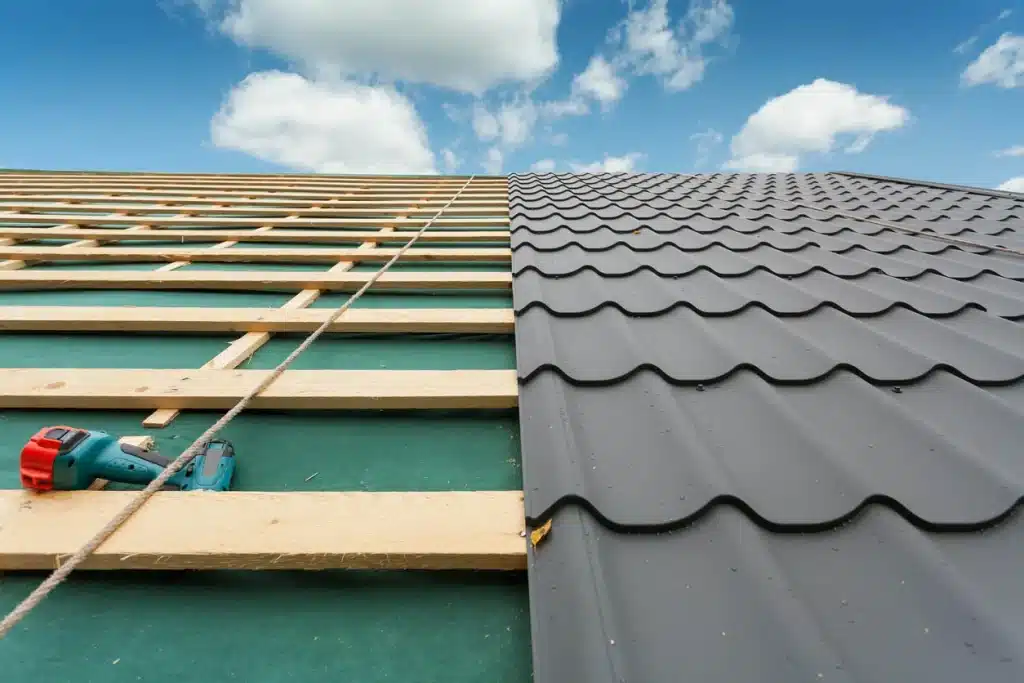When it comes to roofing materials metal roof panels are becoming more and more popular with homeowners and businesses. With their sleek modern look, durability and energy efficiency it’s no wonder more and more people are choosing metal roof panels for their buildings.
In this article we’ll look at the benefits of metal roof panels and why they may be the right choice for your next roofing project.
Before we get into the benefits let’s first define what metal roof panels are. Metal roof panels are large flat sheets of metal used to cover a building. They come in various materials such as steel, aluminum, copper and zinc and can be installed in various styles such as standing seam, corrugated and flat.
Durability and Longevity
by michael schaffler (https://unsplash.com/@schaffler)
One of the big benefits of metal roof panels is their durability and longevity. Unlike traditional roofing materials like asphalt shingles metal roof panels are weather resistant to high winds, heavy rain and hail. They are also fire resistant making them a safer option for your home or business.
Metal roof panels are also known for their longevity with an average lifespan of 40-70 years. That’s much longer than other roofing materials which may need to be replaced every 15-20 years. So by installing metal roof panels you’ll save money in the long run by not having to replace your roof as often.
Energy Efficiency
Another big benefit of metal roof panels is energy efficiency. Metal is a reflective material so it reflects the sun’s rays and keeps your building cooler in the summer. This will help reduce your energy bills by reducing the need for air conditioning.
Some metal roof panels also come with a special coating that can increase their energy efficiency even more. These coatings reflect even more sunlight and keep your building cooler so you’ll get even more energy savings.
Low Maintenance
Metal roof panels are also low maintenance. Unlike other roofing materials that need to be cleaned or repaired often metal roof panels are low maintenance. They are resistant to mold, mildew and rot and can shed debris like leaves and branches.
So you won’t have to spend as much time and money on maintaining your roof and can focus on other things.
Lightweight and Easy to Install
Compared to other roofing materials metal roof panels are relatively lightweight. This makes them easier to install and put less stress on your building’s structure. This is especially good for older buildings that can’t support the weight of heavier roofing materials.
Also metal roof panels are easy to install which can save you time and money on labor costs. They come in large pre-cut sheets that can be installed by a professional roofer in no time.
Versatility in Design
Metal roof panels come in various materials, styles and colors so they are a versatile option for any building. Whether you want a traditional standing seam roof or a modern flat panel design there’s a metal roof panel to suit your style.
Some metal roof panels even come with skylights which can bring natural light into your building and reduce the need for artificial lighting. This will save you money on energy bills and create a more pleasant and welcoming space in your home or business.
Installing metal roof panels is a job best left to the professionals. However, it’s still important to understand the general process of installing metal roof panels to ensure that the job is done correctly.
Step 1: Prepare the Roof
Before installing metal roof panels the roof must be prepared. This means removing old roofing material, repairing any damage and making sure the roof is clean and free of debris.
Step 2: Install Underlayment
by Neven Krcmarek (https://unsplash.com/@nevenkrcmarek)
Next underlayment is installed on the roof. This is a layer of material that sits between the roof and the metal panels. It prevents leaks and also provides extra insulation.
Step 3: Install Flashing
Flashing is installed around any openings in the roof such as chimneys or skylights. This prevents water from seeping into these areas and causing damage.
Step 4: Install Metal Roof Panels
Finally metal roof panels are installed. This is done by screwing or clipping the panels to the roof. The panels are overlapped to create a watertight seal and water to run off the roof.

Many homeowners and businesses have already made the switch to metal roof panels and are enjoying the benefits. Here are a few real-world examples of metal roof panel installations:
The Ford Motor Company
The Ford Motor Company’s Dearborn Truck Plant in Michigan installed a new metal roof with solar panels. This saves them energy and reduces their carbon footprint.
The Empire State Building
The iconic Empire State Building in New York City recently got a major facelift and installed a new metal roof. The new roof is more energy efficient and protects the building from extreme weather.
Conclusion
Metal roof panels have many benefits – durability, energy efficiency, low maintenance and versatility in design. They are also easy to install and can last for decades so they are a cost effective option for any building.
If you’re getting a new roof for your home or business make sure to consider metal roof panels and see how it can benefit you. With so many advantages it’s no wonder metal roof panels are the new standard for roofing.